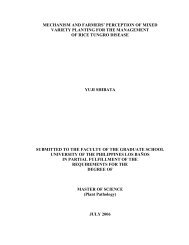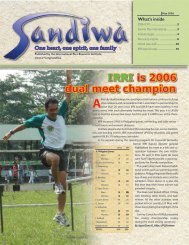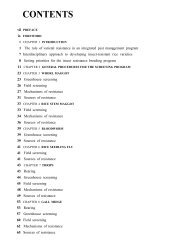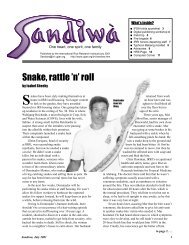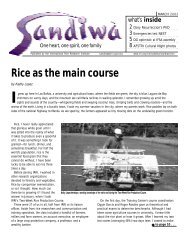Untitled - International Rice Research Institute
Untitled - International Rice Research Institute
Untitled - International Rice Research Institute
You also want an ePaper? Increase the reach of your titles
YUMPU automatically turns print PDFs into web optimized ePapers that Google loves.
For other fungal pathogens, there is a close relation<br />
between seed infection and infected plants<br />
grown from these seeds. An example is blackleg of<br />
crucifer caused by Phoma lingam (Leptosphaeria<br />
maculans) (Gabrielson1983). The classical example<br />
from Heald (1921) indicated that the sporeload of<br />
seeds was highly correlated to the percentage of<br />
smut appearing in the field.<br />
Inoculum thresholds vary according to cultural<br />
environments. In Japan, for instance, after rice cultivation<br />
became mechanized and seedlings were<br />
raised indoors in seedboxes, the occurrence of many<br />
seedborne fungal and bacterial pathogens increased.<br />
This is because the indoor conditions—high temperature<br />
and high humidity with artificial light—are very<br />
favorable for seedling disease development. As a<br />
result, the inoculum threshold is lower than that of<br />
seedlings raised outdoors under a field nursery. The<br />
inoculum becomes more efficient under certain conditions.<br />
Inoculum efficiency is determined by various<br />
factors. The type of disease and crop-growing environments<br />
are important. Gabrielson (1988) cautioned<br />
that thresholds must be developed for average environmental<br />
conditions of crop growth because they<br />
are influenced by all factors affecting the epidemiology<br />
of each host-parasite combination. It is difficult<br />
to use a single threshold of a single disease for all<br />
cropping environments. There is no clear definition<br />
on levels of threshold for the different pathogens detected<br />
from the seed. In rice, different fungal pathogens<br />
are detected from the seed (Table 1) and all of<br />
them are distributed throughout the rice-growing<br />
countries worldwide. Disease potential, however,<br />
depends on the rice ecosystem (upland, rainfed, irrigated,<br />
tropical, subtropical, and temperate environments,<br />
and deepwater and tidal coastal areas), cultural<br />
conditions, and types of crop management and<br />
production. Whether there is a need to treat all diseases<br />
the same way or differently for different ecosystems<br />
and production levels needs careful study.<br />
There is a general agreement that the threshold level<br />
for a disease is zero in an area if it has not been reported<br />
there.<br />
Risk analysis<br />
Risk analysis should serve an important basis for<br />
developing plant quarantine regulations. Risk analysis<br />
based on seed health testing needs to consider the<br />
following factors:<br />
1. type of pathogens<br />
2. role of seed in the life cycle of the<br />
pathogen<br />
3. disease or epidemic potential<br />
4. genetic variability of the pathogen<br />
5. type or site of initial infection<br />
6. kind of crop production environment (Mew<br />
1997)<br />
The risk of infection from seedborne pathogens<br />
is a function of risk probability and risk magnitude.<br />
Furthermore, risk probability is determined by introduction<br />
risk, that is, the probability that a pathogen<br />
enters a region or a field through the seed, the epidemiological<br />
risk, the probability that the pathogen establishes<br />
infection through seedborne inoculum. Risk<br />
magnitude is the potential consequence of an epidemic<br />
caused by the pathogen. Consequences are<br />
considered from the viewpoint of yield loss. Seed<br />
health testing results provide actual data on a pathogen<br />
that could potentially be introduced into a region<br />
or a field. The risk magnitude can be computed from<br />
a yield loss database or from modeling. In rice, this<br />
kind of database is available at IRRI. The yield loss<br />
database provides an estimate of losses and “hazards”<br />
caused by a pathogen once the infection is established<br />
through seedborne inoculum.<br />
However, data are lacking on the transmission<br />
efficiency of seedborne inoculum of many rice<br />
seedborne pathogens. A concerted effort is needed to<br />
compile this information through international collaboration.<br />
<strong>Research</strong> on seed pathology provides the<br />
basis for setting seed health testing policy, while information<br />
on pest or pathogen risk provides a starting<br />
point for seed health testing on target organisms for<br />
plant quarantine regulations. Very limited or no financial<br />
support is available for this important area of<br />
activities.<br />
A yield loss database can estimate the “hazards”<br />
of a pathogen once an infection is established<br />
through the introduction of a seedborne inoculum.<br />
However, data on inoculum levels and thresholds are<br />
also needed to develop realistic assessment or measurement<br />
procedures for some important seedborne<br />
pathogens. Data on seed transmission of many<br />
pathogens and transmission efficiency of seedborne<br />
inoculum are currently not available.<br />
Although conventional seed health testing provides<br />
adequate information on detection frequency<br />
and infection levels of some pathogens, we need to<br />
assess whether these pathogens cause any real injury<br />
to effect yield loss. In scientific literature, this information<br />
is not readily available.<br />
10



